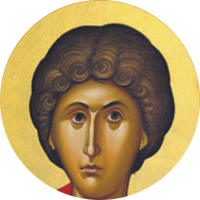The opening of the church created new interest in Saint George. Numerous families joined and the growth continued throughout the decade of the 1980’s. The emphasis was placed in the interior decoration of the Church. Dino Pappas served as the chairman of the Interior Decoration Committee and Father George Papaioannou as advisor. Sirio Tonelli, a Byzantine mosaics artist, was contracted to do the iconography. The people responded to the appeals of the Committee and donated the items for the beautification of the church.
Perhaps what made the St. George parish a success is the family flavor that it helped develop. The founding members believed wholeheartedly that they wanted this to be a family church not a church of strangers. St. George became in the first ten years of its life a home away from home for all its members, especially for those who came to the area from other areas of the country. In the eighties the Membership and Fellowship Committee, under Mrs. Elaine Lailas as chairman, offered a unique service of warm hospitality. Jean Kitsoulas called to welcome every new member. Cassie Economos helped in this effort. Rea Assimakopoulos sent the Saint George postal card to all visitors who signed the guest book. Area coffees were hosted by members in different areas of the community to introduce neighboring members to each other. Every Sunday a large group of members, wearing their “Welcome” badges, served a s greeters in the Founders’ Hall.
St. George has always placed emphasis on good communication between leadership and its members. To provide a better vehicle of communication Father George and the Parish Council decided to publish a monthly magazine with the title, St. George Herald. The St. George Herald served the community well until it was replaced by the St. George Newsletter. Andrew Theodore served as the editor of both.
In the eighties, philanthropy at Saint George. George became a central theme. Kidney transplant patients were arriving in Washington to receive transplants at Georgetown University Hospital. They received not only hospitality at Saint George, but also funds needed for the operation. The patient that received national attention in the 1980’s was Vasilaki, a twelve-year-old boy who needed a liver transplant. The cost for the transplant was $175,000.00. Heading the campaign was Father George with the entire community behind him. The fund raising campaign was very successful. Vasilaki received the new liver at Pittsburgh’s Children’s Hospital. He recovered and returned to Greece. In the 1980’s Saint George received a special blessing, the Kollecas House built next to the church for the accommodation of patients visiting from Greece. The house was a gift from Chris Collier, a Greek Orthodox faithful, and continues to in use to this day.
Another blessing to St. George was the entry into the clergy of one of its own members, Nicholas Despotides, one of the founders of the parish. He was ordained first as a Deacon to assist Father George Papaioannou and later as a Priest who continued to serve with distinction until February, 1999, when he retired.
The dawn of the 1990’s decade offered Saint George new physical expansion. The growth of the Sunday and Greek School programs had created a critical need for additional classroom space. Lambros Hatzilambrou, President of the Parish Council, appointed Stratton Liapis to serve as the chairman for the initial efforts in formulating their plans. Stratton invited a group of parishioners representing the leadership of the community to a dinner meeting at the Bethesda Country Club. The purpose of the meeting was to explore. the needs of the community to be met in the new expansion. Architects and engineers – William Procopiow, Elias Charuhas, John Sporides, and Basil Assimakopoulos – developed some preliminary drawings as a concept for the master plan to be presented to the Parish Assembly. However, an historical Patriarchal visit and the 30th Clergy-Laity Congress occurred at this time that somewhat slowed this building program process.
